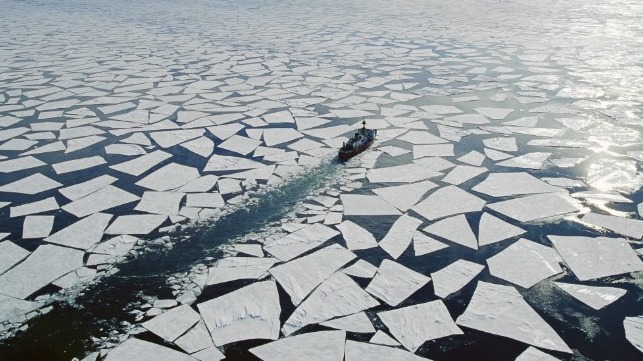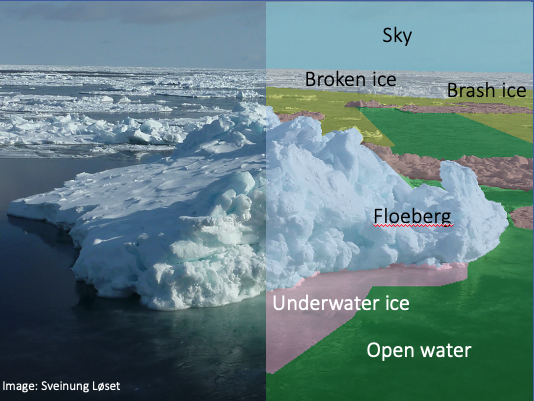What Kind of Sea Ice is That? Thanks to AI, There's an App for That
People snapping photos and uploading them to an AI-driven app could someday help prevent Titanic-scale disasters.

[By Nancy Bazilchuk]
If you’ve watched Netflix, shopped online, or run your robot vacuum cleaner, you’ve interacted with artificial intelligence, AI. AI is what allows computers to comb through an enormous amount of data to detect patterns or solve problems. The European Union says AI is set to be a “defining future technology.”
And yet, as much as AI is already interwoven into our everyday lives, there’s one area of the globe where AI and its applications are in their infancy, says Ekaterina Kim, an associate professor at NTNU’s Department of Marine Technology. That area is the Arctic, an area where she has specialized in studying sea ice, among other topics.
“It’s used a lot in marketing, in medicine, but not so much in Arctic (research) communities,” she said. “Although they have a lot of data, there is not enough AI attention in the field. There’s a lot of data out there, waiting for people to do something with them.”
So Kim and her colleagues Ole-Magnus Pedersen, a PhD candidate from the Department of Marine Technology and Nabil Panchi, from the Indian Institute of Technology Kharagpur, decided to see if they could develop an app that used artificial intelligence to identify sea ice in the Arctic.
The result is "Ask Knut."
Climate change and changing sea ice
You may think there’s not much difference between one chunk of sea ice and another, but that’s just not so. In addition to icebergs, there’s deformed ice, level ice, broken ice, ice floes, floe bergs, floe bits, pancake ice and brash ice.
The researchers wanted the app to be able to distinguish between the different kinds of ice and other white and blue objects out there, like sky, open water and underwater ice.

An example of what the eye sees on the left, and what “Knut” sees on the right. Photo: Sveinung Løset/NTNU
Different kinds of ice really matter to ship captains, for example, who might be navigating in icy waters. Actual icebergs are nothing like brash ice, the floating bits of ice that are two meters in diameter or less. Think of it —the Titanic wouldn’t have sunk if it had just blundered into a patch of brash ice instead of a big iceberg.
Another factor that adds urgency to the situation is climate change, which is dramatically altering sea ice as oceans warm. Even with the help of satellite images and onboard ship technologies, knowing what’s in icy waters ahead can be a difficult challenge, especially in fogs or storms.
“Ice can be very difficult for navigation,” Kim said. “From the water (at the ship level) It can be hard to detect where there is strong ice, multiyear ice, and different ice. Some ice is much more dangerous than other types.”
More kinds of ice than you can possibly imagine
It's often said that Inuit people have many different names for snow — which may or may not be true. But researchers definitely have names for different kinds of ice. Here are the kinds of ice that "Knut" is learning to identify:
- Iceberg: A large piece of freshwater ice that has broken off a glacier or an ice shelf and is floating freely in open (salt) water.
- Deformed ice: A general term for sea ice that has been broken and reoriented. It includes ridged, hummocked, and rafted ice. Deformed ice is distinguished by its high surface roughness.
- Level ice: Sea ice that has been unaffected by deformation.
- Broken ice: Ice that has been broken into pieces.
- Ice floe: A large pack of floating ice often defined as a flat piece at least 20 m across at its widest point, and up to more than 10 km across
- Floe berg: A massive piece of sea ice composed of a hummock or a group of hummocks, frozen together and separated from any ice surroundings. It may float up to 17 ft (5 m) above sea level.
- Floe bit: A smaller version of floe bergs
- Pancake ice: Predominantly circular pieces of ice from 30 cm to 3 m in diameter, and up to about 10 cm in thickness, with raised rims due to the pieces striking against one another. It may be formed on a slight swell from grease ice, shuga, or slush, or as a result of the breaking up of ice rind, nilas, or, under severe conditions of swell or waves, gray ice.
- Brash ice: Accumulation of floating ice made up of fragments not more than 2 m across (small ice cakes); the wreckage of other forms of ice.
Learning from examples
The team began teaching their app’s AI system using a comprehensive collection of photographs taken by another NTNU ice researcher, Sveinung Løset.
But an AI system is like a growing child — if it is to learn, it needs to be exposed to lots of information. That’s where turning the AI into an app made sense. Although the COVID-19 pandemic has shut down most cruise operations, as the pandemic wains, people will begin to take cruises again — including to the Arctic and Antarctic.
Kim envisions tourists using the app to take pictures of different kinds of ice to see who finds the most different kinds of ice. And every one of those pictures helps the app learn.
From cruise ship to classroom
As the AI learns, Kim says, the increasingly complex dataset could be taken into the classroom, where navigators could learn about ice in a much more sophisticated way. Currently, students just look at pictures or listen to a PowerPoint presentation, where lecturers describe the different kinds of ice.
“So this could revolutionize how you learn about ice,” she said. “You could have it in 3-D, you could emerge yourself and explore this digital image all around you, with links to different kinds of ice types.”
This article appears courtesy of Gemini News and may be found in its original form here.
The opinions expressed herein are the author's and not necessarily those of The Maritime Executive.
